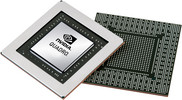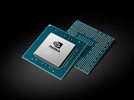NVIDIA Quadro P4200 vs NVIDIA Quadro T1000 Max-Q
NVIDIA Quadro P4200
► remove from comparison
The Nvidia Quadro P4200 is a mobile high-end workstation graphics card for notebooks. It is based on the GP104 chip (like the consumer GeForce GTX 1070 or 1080 for laptops) and features 2304 shader cores. The clock rate is not disclosed but the theoretical SP performance is rated at 8.9 TFLOPs (for the fast Max-P version) and therefore faster than the old Quadro P5000 but below the Quadro P5200 (see table below). The P4200 is equipped with 8 GB GDDR5 which leads to 224 GB7s peak bandwidth due to the 256 Bit memory bus. There are two variants available, a Max-P performance version and a Max-Q version tuned for efficiency (with lower clock speeds).
The Quadro GPUs offer certified drivers, which are optimized for stability and performance in professional applications (CAD, DCC, medical, prospection, and visualizing applications). The performance in these areas is therefore much better compared to corresponding consumer GPUs.
Power Consumption
The power consumption of the Quadro P4200 is rated at 115 Watt TGP (max power consumption incl. memory) and therefore 15 Watt more than the Quadro P5000. The card is therefore best suited for large 17-inch notebooks.
NVIDIA Quadro T1000 Max-Q
► remove from comparison
The Nvidia Quadro T1000 with Max-Q Design is a professional mobile graphics card that is based on the Turing architecture (TU117 chip). Compared to the consumer GTX 1650, the Quadro T1000 features less CUDA cores / shaders (768 versus 896). The chip is manufactured in 12nm FinFET at TSMC. Compared to the normal Quadro T1000, the Max-Q variants are clocked lower and work in a more efficient state. Currently, we know of two variants with different clock speeds and power consumptions (35 and 40 W).
| Model | Shader | TGP (W) | Base (MHz) | Boost (MHz) |
| Quadro T1000 Mobile | 768 | 50 | 1395 | 1455 |
| Quadro T1000 Max-Q | 768 | 40 | 1230 | 1455 |
| Quadro T1000 Max-Q | 768 | 35 | 795 | 1455 |
| Quadro T2000 Mobile | 1024 | 60 | 1575 | 1785 |
| GeForce GTX 1650 Mobile | 896 | 50 | 1395 | 1560 |
The Quadro T1000 is a mobile graphics card that is based on the Turing architecture (TU116 chip). Compared to the faster RTX 2000 GPUs (e.g. RTX 2060), the T1000 integrates no Raytracing or Tensor cores. Due to the same boost clock as the mobile T1000, the Max-Q variants can perform similar with sufficient cooling.
The Turing generation did not only introduce raytracing for the RTX cards, but also optimized the architecture of the cores and caches. According to Nvidia the CUDA cores offer now a concurrent execution of floating point and integer operations for increased performance in compute-heavy workloads of modern games. Furthermore, the caches were reworked (new unified memory architecture with twice the cache compared to Pascal). This leads to up to 50% more instructions per clock and a 40% more power efficient usage compared to Pascal.
Thanks to the low power consumption, the Max-Q T2000 GPU can be used in thin and light laptops. The used TU116 chip is manufactured in 12nm FFN at TSMC.
| NVIDIA Quadro P4200 | NVIDIA Quadro T1000 Max-Q | ||||||||||||||||||||||||||||||||||||||||||||||||||||||||||||||||||||||||||||||||||||||||
| Quadro Turing Series |
|
| |||||||||||||||||||||||||||||||||||||||||||||||||||||||||||||||||||||||||||||||||||||||
| Architecture | Pascal | Turing | |||||||||||||||||||||||||||||||||||||||||||||||||||||||||||||||||||||||||||||||||||||||
| Pipelines | 2304 - unified | 768 - unified | |||||||||||||||||||||||||||||||||||||||||||||||||||||||||||||||||||||||||||||||||||||||
| Core Speed | 1215 - 1480 (Boost) MHz | 795 / 1230 - 1455 (Boost) MHz | |||||||||||||||||||||||||||||||||||||||||||||||||||||||||||||||||||||||||||||||||||||||
| Memory Speed | 7132 MHz | 8000 MHz | |||||||||||||||||||||||||||||||||||||||||||||||||||||||||||||||||||||||||||||||||||||||
| Memory Bus Width | 256 Bit | 128 Bit | |||||||||||||||||||||||||||||||||||||||||||||||||||||||||||||||||||||||||||||||||||||||
| Memory Type | GDDR5 | GDDR5 | |||||||||||||||||||||||||||||||||||||||||||||||||||||||||||||||||||||||||||||||||||||||
| Max. Amount of Memory | 8 GB | 4 GB | |||||||||||||||||||||||||||||||||||||||||||||||||||||||||||||||||||||||||||||||||||||||
| Shared Memory | no | no | |||||||||||||||||||||||||||||||||||||||||||||||||||||||||||||||||||||||||||||||||||||||
| API | DirectX 12_1, Shader 5.0, OpenGL 4.5 | DirectX 12_1, OpenGL 4.6 | |||||||||||||||||||||||||||||||||||||||||||||||||||||||||||||||||||||||||||||||||||||||
| Power Consumption | 115 Watt | 35 - 40 Watt | |||||||||||||||||||||||||||||||||||||||||||||||||||||||||||||||||||||||||||||||||||||||
| technology | 16 nm | 12 nm | |||||||||||||||||||||||||||||||||||||||||||||||||||||||||||||||||||||||||||||||||||||||
| Features | Optimus, PhysX, 3D Vision Pro, nView, Optimus | ||||||||||||||||||||||||||||||||||||||||||||||||||||||||||||||||||||||||||||||||||||||||
| Notebook Size | large | medium sized | |||||||||||||||||||||||||||||||||||||||||||||||||||||||||||||||||||||||||||||||||||||||
| Date of Announcement | 07.05.2018 | 27.05.2019 | |||||||||||||||||||||||||||||||||||||||||||||||||||||||||||||||||||||||||||||||||||||||
| Codename | N19P-Q1 |


 Deutsch
Deutsch English
English Español
Español Français
Français Italiano
Italiano Nederlands
Nederlands Polski
Polski Português
Português Русский
Русский Türkçe
Türkçe Svenska
Svenska Chinese
Chinese Magyar
Magyar